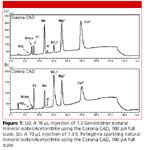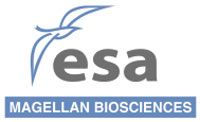Single Run Ion Analysis Using Charged Aerosol Detection: Ion Content of Commercially Available Mineral Water
The analysis of anions and cations is critical during quality control. In this example, all major ionic components in mineral water are identified and quantified in a single run, with no sample preparation or concentration step.
Chris Crafts and Ian Acworth, ESA Biosciences, Inc.
The analysis of anions and cations is critical during quality control. In this example, all major ionic components in mineral water are identified and quantified in a single run, with no sample preparation or concentration step.
Depending on the source, the composition of mineral water can vary greatly. The bottles generally are labeled with the nutritional facts table, but list only the sodium content per serving. The EPA regulates drinking water from public sources with enforceable guidelines under the National Primary Drinking Water Regulations. However, mineral water does not fall under these regulations and instead has a set of non-enforceable guidelines set by the National Secondary Drinking Water Regulations (1). The content of this water can vary greatly and is sometimes above recommended levels.
This application note describes the use of a polymeric zwitterionic stationary phase in HILIC mode for the quantitation of anions and cations in a single run. Following a simple sample preparation step, analysis using a binary gradient HPLC-Charged Aerosol Detection (CAD® ) system enables the quantitation of ionic components found in mineral water (2).
Materials and Methods
A standard HPLC system with a Corona® Charged Aerosol Detector; two store bought bottles of natural mineral water. Samples without extraction were diluted 1:3 with Acetonitrile and then directly injected.
HPLC Parameters:
Column: Sequant ZIC®-pHILIC 5 µm, 4.6 x 150 mm, 30 °C
Mobile Phase A: 100 mM Ammonium formate (pH 4.6);
Methanol; Isopropyl alcohol; Acetonitrile (15:5:20:60)
Mobile Phase B: 30mM Ammonium formate (pH 4.6); Methanol; Isopropyl alcohol; Acetonitrile (65:5:20:10)
Gradient: 20% mobile phase B at 0 min; 20% at 3 min; 90% at 28 min; 90% at 32 min; 15% at 36 min; 20% at 38 min; 20% at 45 min.
Flow Rate: 0.5 mL/min.
Injection Volume: 10 µL
Results
Figure 1a and 1b show typical chromatograms for two commercially available mineral waters. Using this method with Charged Aerosol Detection, both anions and cations are quantified at the same time in a single run. These data demonstrate the utility of this technique for the analysis of ions in mineral water. It is noted that the relative levels of ions vary considerably between mineral water suppliers.

Figure 1
Conclusion
The ZIC-pHILIC column-CAD method is able to separate and qualitatively analyze major ionic components in mineral water in a single run. This method requires no concentration step and can also be used for a large range of applications. The lack of sample preparation and treatment makes this method a great addition to quality processes for secondary water supply sources.
The Corona CAD is a universal detector, not only capable of determining ionic species but also any non-volatile impurity (e.g., trace organics) that may be present in the mineral water sample.
References
(1) 40 CFR post 143.
(2) ESA Application note 70-8377 Ion Analysis of Commercially Available Mineral Water.

ESA Biosciences, Inc.
22 Alpha Road, Chelmsford, MA 01824
tel. (978)250-7000, fax (978)250-7087
Website: www.esainc.com

The Benefits of Custom Bonded Silica
April 1st 2025Not all chromatography resins are created equal. Off-the-shelf chromatography resins might not always meet the rigorous purification requirements of biopharmaceutical manufacturing. Custom bonded silica from Grace can address a wide range of separation challenges, leading to real performance improvements. Discover more about the latest innovations in chromatography silica from Grace, including VYDAC® and DAVISIL®.
5 Things to Consider When Selecting a Chromatography Silica
April 1st 2025Particularly in the pharmaceutical industry, drug purity isn’t just a goal – it’s essential for achieving safety, stability and efficacy. However, purification is easier said than done, especially with challenging molecules like DNA and RNA “oligonucleotides,” due in large part to their diversity and the range of impurities that can be generated during production. Enter DAVISIL® chromatographic silica, with a wide range of pore diameters and particle sizes to meet your specific application, performance and sustainability requirements. Before you choose the chromatography resin for your next purification application, take a look at these 5 considerations.
Automating Protein Purification: Efficiency, Yield, and Reproducibility
March 27th 2025Recent advancements in automated protein purification stress the importance of efficiency, scalability, and yield consistency. This eBook compares different purification platforms, highlighting their impact on downstream applications and demonstrating how automation enhances throughput and process control.
MilliporeSigma: Ultrapure Water for Sensitive LC-MS Analysis of Pesticides
March 25th 2025The aim of the study was to illustrate the efficiency of Milli-Q® water purification systems in eliminating pesticides from tap water, thereby producing and delivering reliable and consistent-quality ultrapure water suitable for pesticides analysis















